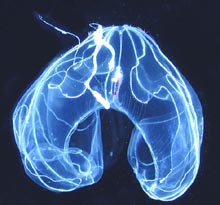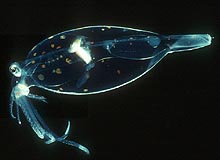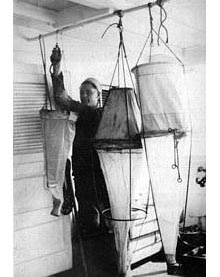
Plankton nets are the most common tool employed in water column research. They have changed little since this picture was taken 90 years ago. They do not adequately collect the full range of organisms that drift and swim throughout the oceans.
Spineless Wonders: The Pelagic Fauna
Russ Hopcroft
Assistant Professor
Institute of Marine Science
University of Alaska, Fairbanks
Overview
For more than 100 years, we have collected animals that drift in the water column with plankton nets. These nets are pulled blindly through the water, collecting primarily the smaller, slower, more numerous and more robust species. Thus, we have been able to adequately sample only a small fraction of the diversity present in the pelagic realm. As a result, we have a notable gap in our understanding of the linkages between algal production, the production of planktonic herbivores, and in turn the production of their predators in the oceans. We are unable to accurately predict when, where and how these soft-bodied animals regulate the flow of the materials and energy through oceanic food webs. In contrast, we know a great deal about the more numerous crustacean zooplankton such as the copepods (the sea’s insects) and euphausiids throughout the world's oceans.

The large copepods, such as Neocalanus, are the best known players in Arctic and subarctic pelagic ecosystems. Click image for larger view.
Remotely Operated Vehicles (ROVs) and submersibles offer opportunities for direct observations of the species that are normally missed by plankton nets because they are either too rare, too fragile, or too fast for us to catch. Undersea vehicles have substantially expanded our knowledge about behavior, biodiversity and vertical distribution of pelagic animals. In addition, submersible tools can permit us to capture live, undamaged specimens. ROVs and submersibles also allow us to make observations on finer scales of space and time than is possible by plankton nets.
During this expedition, we will search the water column under the Arctic ice-sheet for new species of gelatinous zooplankton and cephalopods. We will photograph living animals and their behavior, and we will collect specimens for morphological analysis and molecular fingerprinting. We also plan to assess the vertical distribution and abundance of this fauna relative to that of potential prey and the physical structure of the water column.
Pelagic Fauna in the Arctic

The physonect siphonophores are actually colonies of individuals, each specialized for different functions such as swimming, feeding and reproduction. Click image for larger view and expanded caption. (Photo courtesy of Marsh Youngbluth).
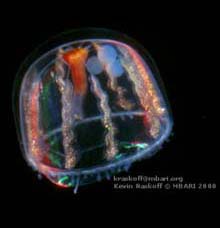
A schematic drawing of the electrophysiology apparatus used to study the color and light sensitivity of deep sea benthic organisms. Click image for larger view.
Gelatinous zooplankton are translucent creatures, often vividly pigmented, as bizarre as they are beautiful. These animals are ubiquitous in the oceans, and many species have persisted for hundred of millions of years. However, we know relatively little about species such as ctenophores, siphonophores, hydromedusae, scyphomedusae, pteropods, heteropods, and pelagic tunicates like salps, doliolids, pyrosomes and larvaceans. The most obvious explanation for this disparity is their extreme fragility. Collecting these animals with nets usually destroys most soft-bodied species or breaks them into fragments that are usually ignored, discarded, misidentified, or simply recorded as “jelly.” Furthermore, conventional preservatives typically dissolve the natural rich iridescent colors of live animals and often liquify them.
Therefore, it is not surprising that scientists underestimate the basic biodiversity as well as the biomass and abundance of gelatinous animals, especially in Arctic seas. Historically, some scientists assumed that these zooplankton are unimportant to ecosystem function. However, recent investigations have demonstrated that these soft-bodied animals are capable of much higher rates of ingestion, growth, and reproduction than crustaceans, which allows them to respond more rapidly to shifts in primary productivity. This fact is especially true in Arctic polynyas, and large populations have been recorded in the Bering Straits.
Until recently, the importance of large populations of carnivorous species has been unappreciated in Arctic surface waters. For example, in the eastern Canadian high Arctic, we have estimated that the ctenophores consume up to 9 percent of the populations of the larger copepods every day. We expect that other gelatinous predators, when numerous, will have similar ecological impacts, particularly medusae and perhaps siphonophores. Several marine scientists have observed mounds of jellyfishes several feet high extending for miles along the shoreline near Barrow, Alaska.
On this expedition, we expect to find many unidentified species of predators, including ctenophores, siphonophores, hydromedusae, and scyphomedusae. These species feed on copepods, euphausiids, larvaceans, other jellies, and fishes. When we learn more about the diversity, occurrence and density of these groups, we will be better able to make predictions about their impact on prey populations in the Arctic.
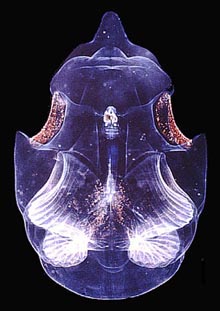
This is an example of a ctenophore, Bathocyroe fosteri, which is a mesopelagic species. (Photo courtesy of Marsh Youngbluth). Click image for larger view.
Presently, the number of species recognized for each group varies depending on the source. A review of the major papers and monographs indicates six species of ctenophores, 45 species of medusae, 12 species of siphonophores, four species of pteropods and five species of larvaceans. Based on our submersible experience in other oceans, we expect to find at least twice as many species in each group during this expedition.
In contrast to the fragile gelatinous zooplankton, we know even less about Arctic cephalopods because they are adept at avoiding nets and trawls. We expect to use the ROV as a beacon for pelagic cephalopods that come to feed on fishes and crustaceans, which will be dazed by the lights of the vehicle. Observations of cephalopods in the water are particularly useful because we can see swimming behaviors and subtle taxonomic characters such as color patterns and skin texture. Gentle collection of specimens with ROV samplers also will provide us with accurate records of size and other shape measurements.
Although cephalopods play an important role in Arctic food webs as effective predators, we still know little about cephalopod fauna. In fact, we know of only seven cephalopod species that reside in the Arctic, and we know nothing about their ecological roles. Recent research on Antarctic cephalopods has revealed a much higher diversity than we first believed. We expect to find a similar case for the Arctic.
Click here for a list of pelagic fauna resources.
Sign up for the Ocean Explorer E-mail Update List.



























